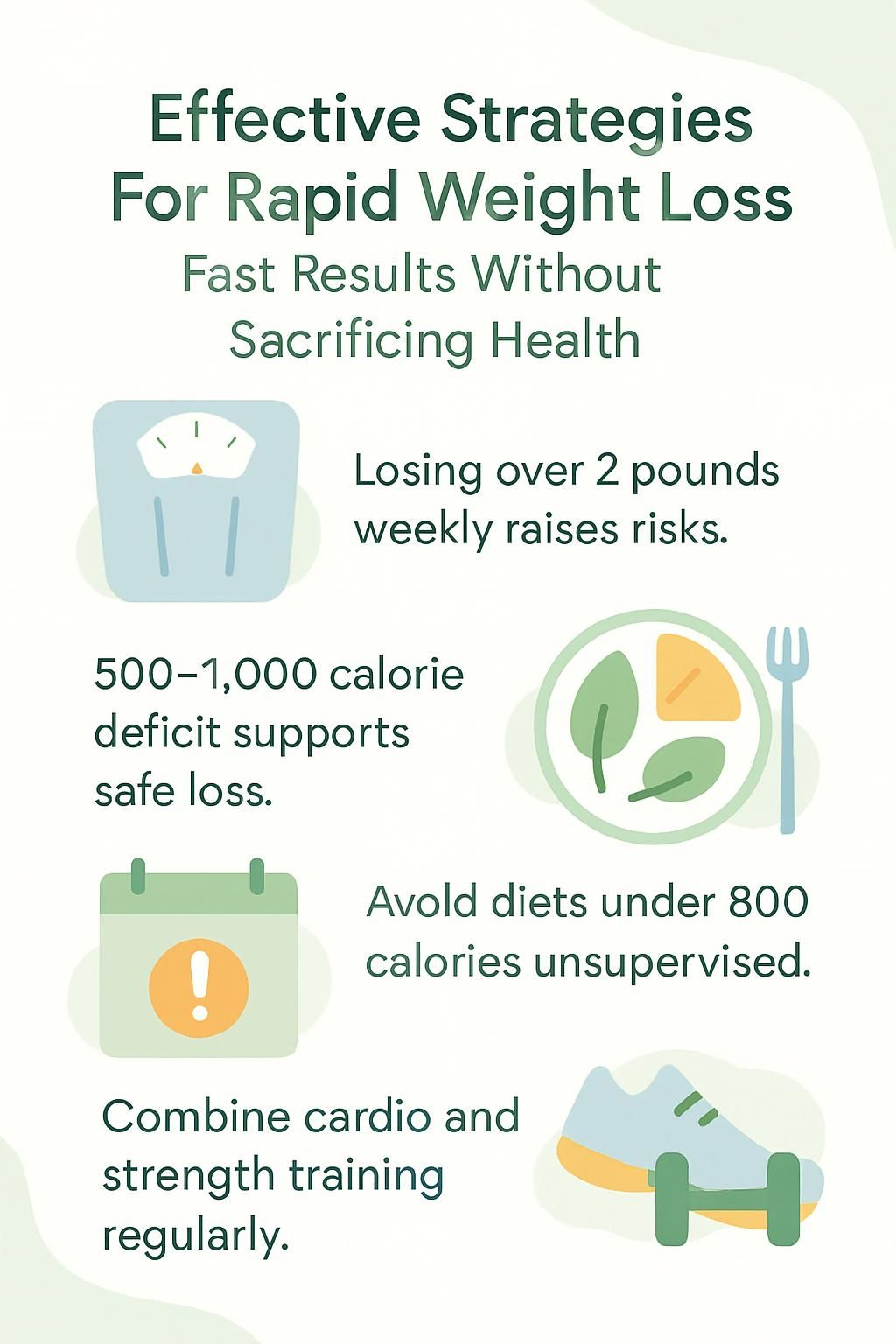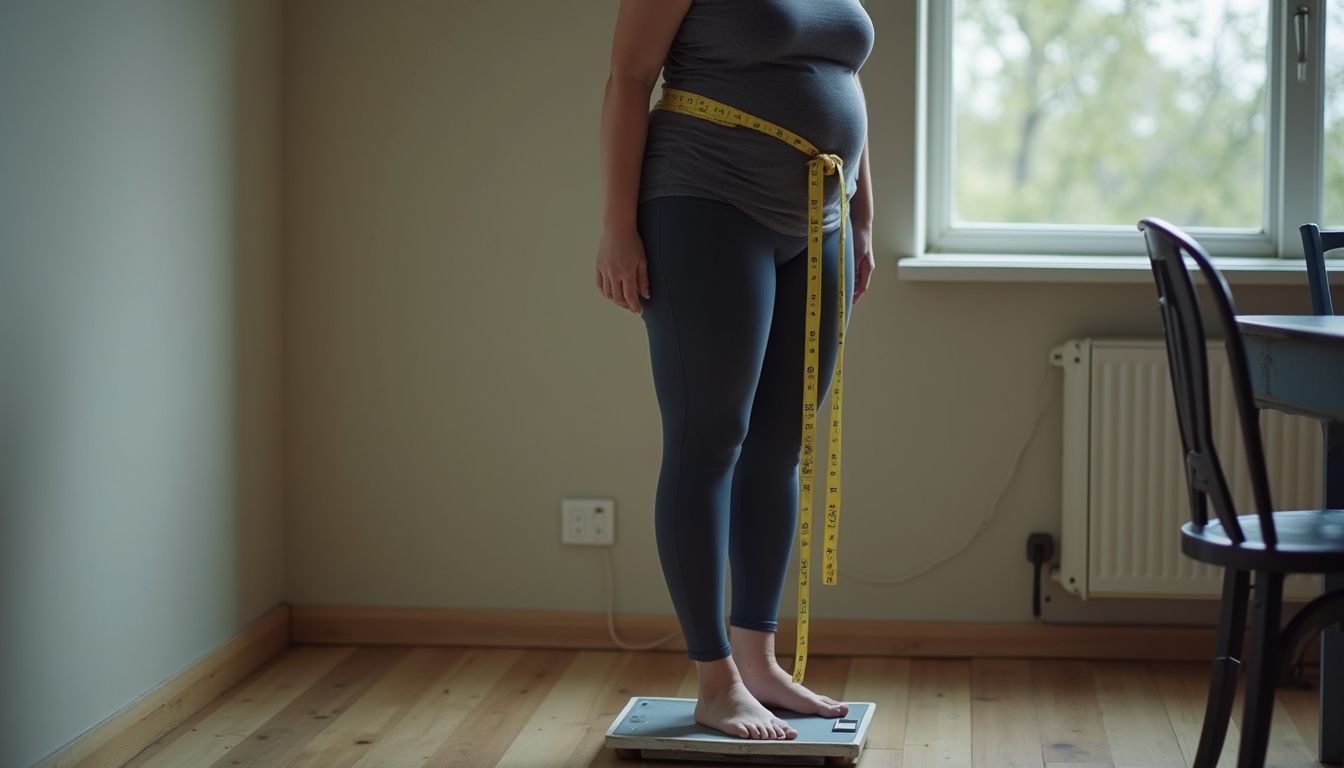Effective Strategies For Rapid Weight Loss: Fast Results Without Sacrificing Health
Our Nutrition Assistant AI Suite will transform your body. You will lose fat, get toned, and build muscle. Gain confidence and optimal health.
Want fast results without harming your health? Rapid weight loss can feel tempting when you need quick progress. It can be done safely with a plan that protects your body and focuses on nutrition and activity.
Rapid weight loss means losing more than two pounds per week. At that speed, risks can rise, including muscle loss and nutrient gaps. In this guide, you will learn practical steps to lose weight quickly while keeping your health front and center.
Key Takeaways
- Rapid weight loss is more than 2 pounds per week. It can raise risks like muscle loss, nutrient deficiencies, slower metabolism, and gallstones, as noted by Mayo Clinic.
- Aim for a balanced calorie deficit of 500 to 1,000 calories per day. Fill your plate with eggs, leafy greens, lean proteins, beans, and whole grains.
- Skip fad plans and very low calorie diets under 800 calories unless a clinician supervises them. Many people regain over half the lost weight within months.
- Pair regular cardio with strength training. This helps you burn fat while preserving muscle, a combo backed by clinical research.
- Track weekly progress, watch symptoms, and get provider support. Safe monitoring boosts short term results and long term maintenance.

Understanding Rapid Weight Loss

Rapid loss is like a sprint, it moves fast and stresses the body more than a steady pace. Knowing what counts as rapid change helps you set safer goals.
What is rapid weight loss?
Losing more than 1 to 2 pounds, or 0.5 to 1 kilogram per week, is considered rapid. Very low calorie diets, called VLCDs, can lead to 3 to 5 pounds per week.
Unintentional loss is concerning if you drop over 10 pounds, or more than 5 percent of your body weight, within 6 to 12 months without trying. Normal daily swings are usually within about 5 pounds due to food and water shifts.
If you see big drops outside that range and you are not changing your diet or exercise, talk with a clinician. Mayo Clinic staff note that unexplained loss can signal a medical issue, such as a thyroid problem or diabetes.
How does rapid weight loss differ from slow weight loss?
Rapid loss often uses very low calorie targets, sometimes around 800 calories per day. This approach can trigger quick changes in body mass index, but it comes with higher risk.
Slow loss focuses on moderate cuts and habits you can maintain. It usually lands at 1 to 2 pounds per week. Health professionals rarely suggest rapid methods unless they can monitor you closely.
Fast plans can cause muscle loss, fatigue, and nutrient gaps. They can also increase gallstone risk and stress hormones. In my own experiment with an aggressive deficit, I hit goal weight, then struggled with energy and cravings once I eased back to normal eating. Reviews show that gradual changes support better long term maintenance and help protect your metabolism.
Risks Associated with Rapid Weight Loss
Rapid change can work, but it can also bring side effects if you go too hard. Understanding the risks helps you choose a safer path.
Can rapid weight loss cause muscle loss and slow metabolism?
Yes. Losing weight too fast can lead to muscle loss, not just fat loss. When you drop more than 1 to 2 pounds per week, your body may use lean tissue for energy.
Less muscle usually means a slower metabolism. This makes it tougher to keep weight off later. Research shows that severe calorie cuts, especially in older adults, can slow daily energy burn after a big drop in muscle.
What are the dangers of nutritional deficiencies during rapid weight loss?
Cutting calories too far raises the chance of missing key nutrients like iron, potassium, vitamin B12, calcium, and protein. Symptoms can include fatigue, weak immunity, hair thinning, dry skin, and more frequent illness.
Digestive problems, such as constipation or diarrhea, are also common. Meal replacement plans and fad diets that skip food groups raise the risk if a clinician is not guiding you. Serious deficits can also worsen muscle loss and slow recovery.
Why does rapid weight loss increase the risk of gallstones?
During fast loss, your liver releases more cholesterol into bile while mobilizing fat. When bile gets too concentrated, cholesterol can form stones.
Very low calorie plans also slow gallbladder emptying. That makes stones more likely. People who lose more than about 3 pounds per week face higher risk than those who lose slowly.
How likely is long-term weight regain after rapid weight loss?
Regain is common after very fast loss. Many people who use extreme cuts regain much of the weight within one to two years. Strict plans can slow metabolism and trigger rebound hunger, which fuels overeating once the plan ends.
The Mayo Clinic notes that a large share of people who slash calories quickly regain more than half the lost weight within months. A steadier approach, built on daily habits, has a better track record for maintenance.
Implementing Healthy Strategies for Rapid Weight Loss
You can move fast and stay safe with structure, not shock. Aim for fat loss while you protect muscle and energy.
How to create a balanced calorie deficit for rapid weight loss?
- Find your maintenance calories with a trusted calculator or a registered dietitian.
- Target a deficit of 500 to 1,000 calories per day. That usually supports 0.5 to 2 pounds lost per week.
- Use a Low Calorie Diet, often 1,200 to 1,500 calories for women and 1,500 to 1,800 for men. Avoid VLCDs under 800 calories unless a clinician supervises them.
- Center meals on vegetables, whole grains, lean proteins, beans, and healthy fats. This limits nutrient gaps and helps protect your metabolism.
- Drink water through the day. Hydration supports digestion, appetite control, and fat breakdown.
- Track your intake with an app or journal. Patterns become clear when you write them down.
- Watch for red flags, such as ongoing fatigue, dizziness, or frequent illness. If you lose more than 5 percent of body weight in weeks and feel unwell, contact your provider.
- Adjust the deficit if energy, mood, or blood pressure dip. A plan you can keep is more effective than a plan you cannot finish.
- Plan meals ahead. This lowers the urge to chase quick fixes or unproven supplements.
- Add regular exercise, cardio plus strength training. It boosts fat loss and helps preserve lean mass.
- Check progress weekly with the scale and a waist measure. This helps you separate real change from normal water shifts.
What are the best nutrient-dense foods for losing weight fast?
Nutrient-dense foods give you more nutrition per calorie. They keep you full and support muscle while you cut calories.
- Eggs offer complete protein that supports muscle repair.
- Leafy greens, such as spinach and kale, add fiber and key vitamins for fullness.
- Chicken breast and turkey provide lean protein with few calories.
- Plain Greek yogurt delivers protein, calcium, and helpful probiotics.
- Beans and lentils add fiber and plant protein that curb hunger.
- Berries, including strawberries and blueberries, are high in fiber and antioxidants.
- Salmon and other fatty fish supply omega 3 fats that support heart health.
- Broccoli and other cruciferous vegetables add volume, fiber, and protective nutrients.
- Nuts like almonds support satiety. Keep portions small due to calorie density.
- Clinician-approved meal replacements can be useful in structured plans.
- Quinoa adds protein, fiber, iron, and magnesium for steady energy.
Why is hydration important during rapid weight loss?
Fast weight loss often increases water loss through urine and sweat. Some plans, fasting windows, or supplements can add to this effect. Digestive changes like constipation or diarrhea can also drain fluids.
During an intermittent fasting phase, I ignored water intake and felt lightheaded and tired. Hydrating fixed the headaches and improved focus. Mild dehydration can lower energy and performance. Keeping fluids up makes the process smoother and safer.
| Factor | Effect on Fluid Needs |
|---|---|
| Higher water loss | Increases need due to fat breakdown and extra urine |
| Constipation or diarrhea | Raises dehydration risk, calls for more fluids |
| Supplement use | Some products increase urine output |
Good hydration helps prevent headaches, fatigue, muscle cramps, and kidney strain while you lose weight.
Effective Diet Plans for Rapid Weight Loss
Structured plans reduce guesswork. The right plan should protect muscle, cover nutrients, and fit your daily life.
What are Very Low-Calorie Diets (VLCD) and how do they work?
A Very Low Calorie Diet provides fewer than 800 calories per day. Clinicians use them for adults with obesity in specific cases, such as before surgery. These plans rely on medical meal replacements that include vitamins and minerals.
Typical losses range from 3 to 5 pounds per week. Due to risks like nutrient gaps and muscle loss, VLCDs usually last up to 12 weeks with close medical monitoring. They are not a do it yourself option.
How can Low-Calorie Diets (LCD) help with rapid weight loss?
Low Calorie Diets set daily targets of about 1,200 to 1,500 calories for women and 1,500 to 1,800 for men. Many people mix real foods with one or two meal replacements to make tracking easier.
This approach creates a steady deficit that targets fat, not muscle. Friends who used an LCD with clinician support saw steady changes around the waist and improved blood lipids. Controlled plans usually beat fad diets that cut food groups or push detox claims.
What is intermittent fasting and how does it aid weight loss?
Intermittent fasting rotates eating and fasting windows to help lower weekly calories and improve glucose control. One option is the 5:2 plan. You eat very few calories on two nonconsecutive days, then eat normally the other five days.
During fasting hours, your body uses stored fat for energy. Short term studies suggest it can support rapid loss without large drops in muscle if protein and training are in place. I used a simple fasting window after a prediabetes warning. Four weeks later I was down 10 pounds and felt steady energy.
What are the benefits of time-restricted eating for weight loss?
Time restricted eating limits eating to a daily window, such as 16 hours fasting and 8 hours eating. Many people find it easier than counting every calorie. It often cuts late night snacking and reduces hunger swings after the first week.
Research shows it can support meaningful loss when paired with a balanced diet and activity. Long term data is still growing. Treat it as a tool, not a rule.
Exercise’s Impact on Rapid Weight Loss
Food creates the deficit, movement speeds the result. Training also protects your muscle engine while the scale moves.
How does cardio help burn fat for rapid weight loss?
Cardio raises your heart rate and increases calorie burn during and after the session. Moderate to high intensity work uses stored fat for fuel. Even short sessions add up when you are in a calorie deficit.
Good choices include brisk walking, cycling, swimming, or rowing. Pairing cardio with a low energy diet improves fat loss and helps prevent regain. Small, frequent sessions can beat long, rare ones.
Why is strength training important for preserving muscle?
Without resistance work, up to one quarter of the weight you lose can be muscle. Strength training tells your body to keep lean tissue, even with fewer calories.
Two or more sessions per week that train major muscle groups work well. This is vital for older adults and postmenopausal women, who face age related muscle decline. Keeping muscle helps keep your metabolism higher as you lose.
What are the benefits of High-Intensity Interval Training (HIIT)?
HIIT alternates short intense bursts with brief recovery. Sessions often take 20 to 30 minutes. Research shows HIIT can boost calorie burn for hours after you finish, which speeds fat loss and helps preserve muscle.
Start with simple intervals, such as 30 seconds hard and 60 seconds easy. If you have medical conditions or take medications, check with a clinician before starting a new program.
Lifestyle Adjustments for Sustaining Rapid Weight Loss
Daily habits make quick progress stick. Small changes to sleep, stress, and eating style can protect your results.
How does quality sleep affect weight loss results?
Adults need 7 to 9 hours of quality sleep. Poor sleep raises ghrelin, the hunger hormone, and lowers leptin, the fullness signal. That can make you eat more and move less.
People who sleep under six hours per night struggle more with fat loss and maintenance. In college, I pulled late nights and craved snacks the next day. Once I fixed my sleep, hunger and workouts improved.
What stress management techniques support weight loss?
Brisk walking, yoga, or light lifting lowers stress and improves mood. Mindfulness practices, such as guided breathing or short meditations, reduce emotional eating.
Cut caffeine late in the day and set a wind down routine to support sleep. I added a 10 minute breathing practice before bed, which made it easier to skip late night snacks. Alcohol can increase appetite and disrupt sleep, so keep it modest.
How can mindful eating improve weight loss success?
Mindful eating helps you notice hunger, fullness, and triggers. It turns mealtime into a skill you can practice.
- Chew slowly and focus on each bite so fullness can catch up.
- Check hunger and fullness before seconds. Studies show mindful eaters keep weight off more easily.
- Turn off screens at meals. Distraction often leads to extra calories.
- List your triggers, such as stress or boredom, then plan a nonfood response.
- Pick nutrient dense foods that satisfy on fewer calories.
- Pay attention to taste and texture. If smell or taste is reduced, tune into temperature and mouthfeel.
- Track unusual symptoms or rapid loss you did not intend. Call your clinician if it continues.
- Avoid extreme cleanses and unproven detox plans. They often backfire.
- Set realistic goals, especially for older adults, to protect muscle while you lose fat.
These skills support both quick progress and long term maintenance.
Avoiding Common Pitfalls in Rapid Weight Loss
Fast change works best when you avoid traps that slow you down later. Set fair targets and monitor the right signals.
Why should fad diets be avoided?
Fad diets often cut whole food groups or slash calories. You may lose fast but also lose muscle and slow your metabolism. Many people regain soon after stopping because habits did not change.
These plans can cause nutrient gaps and raise gallstone risk. Research in 2021 linked quick fix dieting to more disordered eating in teens and adults. A balanced calorie deficit with real food is safer and more effective.
How to set realistic weight loss goals?
Aim for 0.5 to 1 pound per week. Faster rates raise risks like muscle loss, nutrient gaps, and gallstones. If your goal is 10 pounds, plan about 10 weeks.
Break big goals into small steps. Track weekly to see trends, not daily noise. Adjust based on results instead of making extreme changes.
What are effective ways to monitor progress and adjust strategies?
- Weigh in once a week at the same time of day.
- Measure waist and hips every two weeks to track fat loss.
- Log symptoms like fatigue, weakness, or dizziness. These can signal nutrient issues or an overly aggressive deficit.
- Keep a food diary. It reveals hidden calories and missed protein.
- Note digestive changes that persist, such as bloating or abdominal pain. Ask your clinician about screening if symptoms continue.
- Track water intake daily to prevent dehydration and reduce gallstone risk.
- Use apps or wearables to log steps and workouts.
- Schedule regular check ins with a healthcare provider. They may order lab tests or imaging if concerns arise.
- Adjust monthly. If you stall, review portions, protein, sleep, and activity before cutting more calories.
Consistent monitoring gives clear feedback and protects your long term results.
Consulting a Doctor for Rapid Weight Loss
Quick loss can be safe, but sudden changes can also hint at a health issue. Know the signs that call for care.
What symptoms indicate unintentional weight loss?
Unintentional loss is a drop of more than 10 pounds, or over 5 percent of your body weight, in 6 to 12 months without trying. Clothes fit looser, and friends may notice.
Other signs include fatigue, frequent illness, lower appetite, mood changes, or stomach pain. If your weight shifts more than about 5 pounds a day without a clear reason, contact a clinician. Thyroid disease, diabetes, and other conditions can cause this pattern.
When should you check for underlying health issues?
Book a medical visit if you lose weight without changing eating or activity. Your provider may order blood tests for diabetes, celiac disease, infection, thyroid, or adrenal issues. They may also suggest screening exams or imaging to look deeper.
A simple urinalysis can check hydration and kidney strain. I helped a friend who was losing weight unexpectedly. Early testing found a thyroid disorder, and treatment improved energy and appetite.
How can professional weight management advice help?
Clinicians tailor goals, calorie targets, and protein needs to your health status. They also watch for side effects like nutrient gaps, gallstones, or muscle loss.
If you take medicines or have conditions that affect appetite or digestion, professional guidance keeps you safe while you lose. People who get expert support are more likely to keep weight off over time.
Benefits of Achieving Healthy Rapid Weight Loss
Healthy rapid weight loss can lift energy and mood. It can also reduce risk for several diseases tied to excess weight.
How does rapid weight loss boost energy and confidence?
Carrying less weight eases stress on your heart, joints, and lungs. Many people report more stamina within weeks after losing about 5 percent of body weight.
Visible progress boosts confidence. After I lost 10 pounds in a month using a balanced deficit and strength work, I felt stronger and more focused. That momentum made it easier to keep healthy habits.
What obesity-related diseases risk decreases after weight loss?
Losing weight can improve blood sugar, blood pressure, and cholesterol. It also lowers risk for heart disease, stroke, fatty liver disease, and some cancers.
| Disease or Condition | Typical Improvement After Weight Loss |
|---|---|
| Type 2 Diabetes | Up to 58 percent risk reduction with sustained lifestyle change |
| High Blood Pressure | Meaningful drops after 5 to 10 percent body weight loss |
| Heart Disease and Heart Failure | Lower strain on the heart and improved risk factors |
| Certain Cancers | Lower risk for colon and breast cancer |
| Metabolic Disorders | Better insulin sensitivity and less fatty liver |
These health gains support a longer, more active life and make weight maintenance easier.
How does rapid weight loss improve overall well-being?
Safe rapid loss can lift mood, sharpen focus, and improve sleep quality. Nutritious foods and regular movement reduce inflammation and support heart health.
As energy rises, you may move more and socialize more. That creates a positive cycle that makes maintenance more likely.
Conclusion
Fast results and good health can go together with the right plan. Set a balanced calorie deficit, eat nutrient dense foods, and hydrate well. Combine cardio with strength training to burn fat and keep muscle. Sleep, stress skills, and mindful eating help you stick with it.
If you see unexplained loss or worrisome symptoms, contact a clinician. This article is educational and not medical advice. A healthcare professional can personalize your approach.
Stay consistent with safe habits and steady tracking. You will improve health markers, reduce disease risk, and build confidence as the scale moves.
FAQs
1. What are effective strategies for rapid weight loss that do not harm health?
Effective strategies for rapid weight loss include eating fewer calories, increasing physical activity, and choosing nutrient-rich foods. Research shows that combining these methods leads to better results without risking health.
2. How does advertising influence weight loss choices?
Advertising often promotes quick fixes or supplements for weight loss and can shape public opinion about what works best. Studies suggest many advertised products lack scientific support; always check evidence before following such advice.
3. Can fast results in weight loss be maintained long-term?
Fast results from strict diets may not last if healthy habits are not continued. Evidence supports gradual changes in diet and exercise as more sustainable ways to keep off lost pounds over time.
4. Is there a safe rate of losing body fat during a weight loss plan?
Experts recommend aiming to lose one to two pounds per week through balanced nutrition and regular movement. This pace helps protect muscle mass while reducing the risk of regaining lost body fat later.
Summary: Rapid weight loss is possible with careful planning focused on calorie control, increased activity, and reliable information rather than relying on advertising claims alone. Sustainable progress comes from steady lifestyle changes supported by credible research findings.







